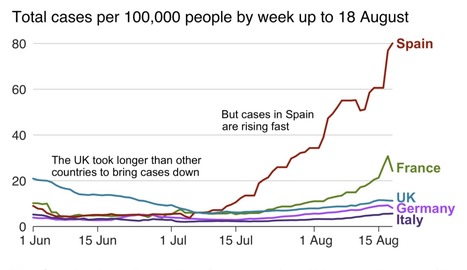Spain saw one of the most draconian Covid-19 lockdowns in Europe, but two months after it was lifted, the virus is spreading faster than in any neighbouring nation. It now has Europe's fastest-rising caseload, with 142 positive cases per 100,000 inhabitants over the past two weeks. By the time the state of emergency ended on 21 June, Spain was registering 100 to 150 cases per day. That number has risen to more than 3,000. But the number of deaths over the past week stood at 122 on Thursday, a far cry from the 950 registered on 2 April alone, the blackest day in Europe's deadliest per capita coronavirus epidemic. Most of the transmission is now between young people, and around three-quarters of positives are in patients who show no symptoms. Spain's government admits the numbers are "not what we want to see", but points to key differences compared to the spring. Only around 3% of current cases require hospital treatment, less than 0.5% need intensive care and the current death rate is as low as 0.3%. "Mortality is very low, as is the hospitalisation rate. Something has changed big time, although the rise is still worrying," says Ildefonso Hernández, a professor in public health from Miguel Hernández University in Alicante. "As long as cases are rising, we have to think that a second wave is on the way. We don't have much time to react before September's return to routines."
Spain's tourism season has ended up as little more than a damp squib, as most countries moved to blacklist this key destination within weeks of the country opening up at the end of June. That means beach areas have so far avoided the highest rates of infection, although Catalonia's infection rate is slightly above the national average on 145 cases per 100,000 inhabitants. Healthcare is a competence of Spain's 17 regions, and some are looking much better prepared than others. At the good end of the scale, the northern region of Asturias has an infection rate of 32, while Aragón in the north-east is topping 500. Aragón's capital, Zaragoza, has become a hotspot for community transmission over recent weeks, but the problems began in the early summer when thousands of seasonal workers, many of them wandering migrants, began to travel to orchards in the region. Growers and packing companies have been criticised for not providing accommodation for migrant workers, leading them to travel between shelters and fields or subsist in insanitary shanties. "Everything happening in Aragón is very much connected to outbreaks among the seasonal fruit-pickers. There should have been more anticipation of the problems that could arise due to the accommodation situation of these workers," explains Juan González Armengol, president of the Spanish Society of Emergency Medicine (Semes). Worst of all, more than 55 care homes for the elderly in Aragón have registered cases since the end of the state of emergency..



 Your new post is loading...
Your new post is loading...







